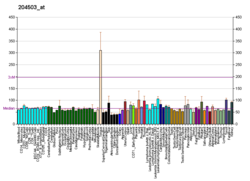| EVPL | |||||||||||||||||||||||||||||||||||||||||||||||||||
|---|---|---|---|---|---|---|---|---|---|---|---|---|---|---|---|---|---|---|---|---|---|---|---|---|---|---|---|---|---|---|---|---|---|---|---|---|---|---|---|---|---|---|---|---|---|---|---|---|---|---|---|
| |||||||||||||||||||||||||||||||||||||||||||||||||||
| Identifiers | |||||||||||||||||||||||||||||||||||||||||||||||||||
| Aliases | EVPL, EVPK, envoplakin | ||||||||||||||||||||||||||||||||||||||||||||||||||
| External IDs | OMIM: 601590; MGI: 107507; HomoloGene: 1506; GeneCards: EVPL; OMA:EVPL - orthologs | ||||||||||||||||||||||||||||||||||||||||||||||||||
| |||||||||||||||||||||||||||||||||||||||||||||||||||
| |||||||||||||||||||||||||||||||||||||||||||||||||||
| |||||||||||||||||||||||||||||||||||||||||||||||||||
| |||||||||||||||||||||||||||||||||||||||||||||||||||
| |||||||||||||||||||||||||||||||||||||||||||||||||||
| Wikidata | |||||||||||||||||||||||||||||||||||||||||||||||||||
| |||||||||||||||||||||||||||||||||||||||||||||||||||
Envoplakin is a protein that in humans is encoded by the EVPL gene.
Interactions
Envoplakin has been shown to interact with PPL.
See also
References
- ^ GRCh38: Ensembl release 89: ENSG00000167880 – Ensembl, May 2017
- ^ GRCm38: Ensembl release 89: ENSMUSG00000034282 – Ensembl, May 2017
- "Human PubMed Reference:". National Center for Biotechnology Information, U.S. National Library of Medicine.
- "Mouse PubMed Reference:". National Center for Biotechnology Information, U.S. National Library of Medicine.
- Ruhrberg C, Williamson JA, Sheer D, Watt FM (Mar 1997). "Chromosomal localisation of the human envoplakin gene (EVPL) to the region of the tylosis oesophageal cancer gene (TOCG) on 17q25". Genomics. 37 (3): 381–5. doi:10.1006/geno.1996.0573. PMID 8938451.
- Risk JM, Ruhrberg C, Hennies H, Mills HS, Di Colandrea T, Evans KE, Ellis A, Watt FM, Bishop DT, Spurr NK, Stevens HP, Leigh IM, Reis A, Kelsell DP, Field JK (Sep 1999). "Envoplakin, a possible candidate gene for focal NEPPK/esophageal cancer (TOC): the integration of genetic and physical maps of the TOC region on 17q25". Genomics. 59 (2): 234–42. doi:10.1006/geno.1999.5857. PMID 10409435.
- "Entrez Gene: EVPL envoplakin".
- Karashima, Tadashi; Watt Fiona M (Dec 2002). "Interaction of periplakin and envoplakin with intermediate filaments". J. Cell Sci. 115 (Pt 24): 5027–37. doi:10.1242/jcs.00191. ISSN 0021-9533. PMID 12432088.
- Ruhrberg, C; Hajibagheri M A; Parry D A; Watt F M (Dec 1997). "Periplakin, a novel component of cornified envelopes and desmosomes that belongs to the plakin family and forms complexes with envoplakin". J. Cell Biol. 139 (7): 1835–49. doi:10.1083/jcb.139.7.1835. ISSN 0021-9525. PMC 2132639. PMID 9412476.
Further reading
- Ruhrberg C, Hajibagheri MA, Simon M, et al. (1996). "Envoplakin, a novel precursor of the cornified envelope that has homology to desmoplakin". J. Cell Biol. 134 (3): 715–29. doi:10.1083/jcb.134.3.715. PMC 2120946. PMID 8707850.
- Steinert PM, Marekov LN (1997). "Direct evidence that involucrin is a major early isopeptide cross-linked component of the keratinocyte cornified cell envelope". J. Biol. Chem. 272 (3): 2021–30. doi:10.1074/jbc.272.3.2021. PMID 8999895.
- Robinson NA, Lapic S, Welter JF, Eckert RL (1997). "S100A11, S100A10, annexin I, desmosomal proteins, small proline-rich proteins, plasminogen activator inhibitor-2, and involucrin are components of the cornified envelope of cultured human epidermal keratinocytes". J. Biol. Chem. 272 (18): 12035–46. doi:10.1074/jbc.272.18.12035. PMID 9115270.
- Ruhrberg C, Hajibagheri MA, Parry DA, Watt FM (1998). "Periplakin, a novel component of cornified envelopes and desmosomes that belongs to the plakin family and forms complexes with envoplakin". J. Cell Biol. 139 (7): 1835–49. doi:10.1083/jcb.139.7.1835. PMC 2132639. PMID 9412476.
- Marekov LN, Steinert PM (1998). "Ceramides are bound to structural proteins of the human foreskin epidermal cornified cell envelope". J. Biol. Chem. 273 (28): 17763–70. doi:10.1074/jbc.273.28.17763. PMID 9651377.
- Määttä A, Ruhrberg C, Watt FM (2000). "Structure and regulation of the envoplakin gene". J. Biol. Chem. 275 (26): 19857–65. doi:10.1074/jbc.M001028200. PMID 10747979.
- Lee CH, Marekov LN, Kim S, et al. (2000). "Small proline-rich protein 1 is the major component of the cell envelope of normal human oral keratinocytes". FEBS Lett. 477 (3): 268–72. doi:10.1016/S0014-5793(00)01806-8. PMID 10908733. S2CID 12228606.
- DiColandrea T, Karashima T, Määttä A, Watt FM (2000). "Subcellular distribution of envoplakin and periplakin: insights into their role as precursors of the epidermal cornified envelope". J. Cell Biol. 151 (3): 573–86. doi:10.1083/jcb.151.3.573. PMC 2185584. PMID 11062259.
- Kazerounian S, Uitto J, Aho S (2003). "Unique role for the periplakin tail in intermediate filament association: specific binding to keratin 8 and vimentin". Exp. Dermatol. 11 (5): 428–38. doi:10.1034/j.1600-0625.2002.110506.x. PMID 12366696. S2CID 25735126.
- Karashima T, Watt FM (2003). "Interaction of periplakin and envoplakin with intermediate filaments". J. Cell Sci. 115 (Pt 24): 5027–37. doi:10.1242/jcs.00191. PMID 12432088.
- Strausberg RL, Feingold EA, Grouse LH, et al. (2003). "Generation and initial analysis of more than 15,000 full-length human and mouse cDNA sequences". Proc. Natl. Acad. Sci. U.S.A. 99 (26): 16899–903. Bibcode:2002PNAS...9916899M. doi:10.1073/pnas.242603899. PMC 139241. PMID 12477932.
- Kalinin AE, Idler WW, Marekov LN, et al. (2004). "Co-assembly of envoplakin and periplakin into oligomers and Ca(2+)-dependent vesicle binding: implications for cornified cell envelope formation in stratified squamous epithelia". J. Biol. Chem. 279 (21): 22773–80. doi:10.1074/jbc.M313660200. PMID 15033990.
- Suzuki Y, Yamashita R, Shirota M, et al. (2004). "Sequence comparison of human and mouse genes reveals a homologous block structure in the promoter regions". Genome Res. 14 (9): 1711–8. doi:10.1101/gr.2435604. PMC 515316. PMID 15342556.
- Iwaya T, Maesawa C, Kimura T, et al. (2005). "Infrequent mutation of the human envoplakin gene is closely linked to the tylosis oesophageal cancer locus in sporadic oesophageal squamous cell carcinomas". Oncol. Rep. 13 (4): 703–7. doi:10.3892/or.13.4.703. PMID 15756445.
This article on a gene on human chromosome 17 is a stub. You can help Misplaced Pages by expanding it. |




